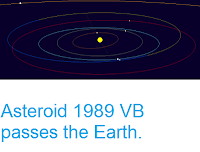Asteroid 2017 TA passed by the Earth at a distance of about 1 021 000
km (2.66 times the average distance between the Earth and the Moon, or 0.68% of the distance between the Earth and the Sun), slightly after 9.30 pm
GMT on Friday 6 October 2017. There was no danger of
the asteroid hitting us, though were it to do so it would have
presented a real threat. 2017 TA has an estimated
equivalent
diameter of 21-85 m (i.e. it is estimated that a spherical object
with
the same volume would be 21-85 m in diameter), and an object at the
upper end of this
size range would be predicted to be capable of
passing through the Earth's
atmosphere relatively intact, and explode in
an airburst (an explosion caused by superheating from friction with the
Earth's atmosphere, which is greater than that caused by simply
falling, due to the orbital momentum of the asteroid), less than a kilometre above the ground, in an
explosion that would be 1650 times as powerful as the
Hiroshima
bomb. This would not be large enough to cause global effects, but would be pretty unpleasant for anyone directly underneath.
The calculated orbit of 2017 TA. Minor Planet Center.
2017 TA was discovered on 3 October 2017 (three days before its closest approach to the Earth) by the
University of Arizona's Mt. Lemmon Survey at the Steward Observatory on Mount
Lemmon in the Catalina Mountains north of Tucson. The designation 2017 TA
implies that the asteroid was the first object (object A) discovered in the first half of October 2017 (period 2017 T).
2017 TA has a 540 day orbital period and an eccentric orbit
tilted at an angle of 19.8° to the plane of the Solar System, which
takes it from 0.99 AU from the Sun (i.e. 99% of he average distance at
which the Earth orbits the Sun, slightly inside the orbit of Venus) to 1.60 AU from the Sun (i.e. 160% of
the
average distance at which the Earth orbits the Sun, slightly more than the
distance at which the planet Mars orbits). It is therefore
classed as an
Apollo Group Asteroid (an asteroid that is on average further from the
Sun than the Earth, but which does get closer). Close
encounters between the 2017 TA and Earth are common, with the
last thought to have happened in October 2014 next predicted
in September 2020.
See also...
Follow Sciency Thoughts on
Facebook.







